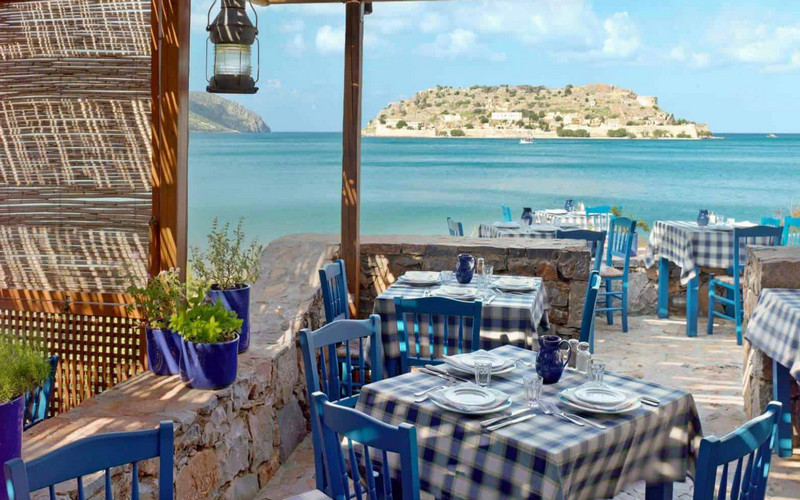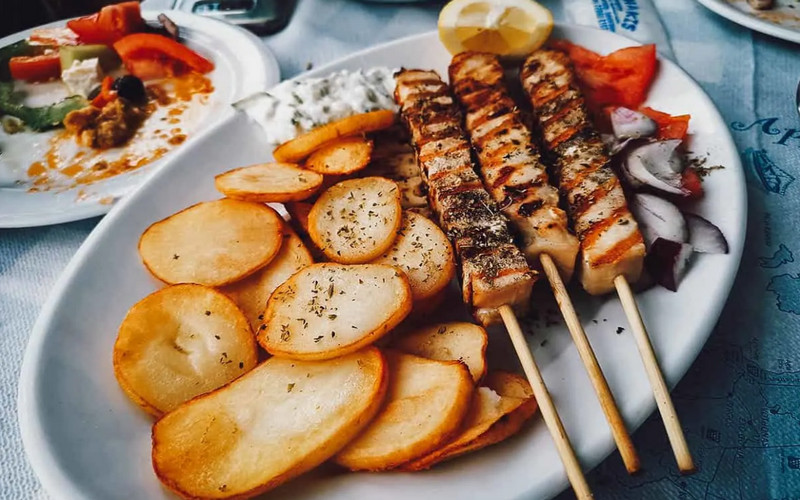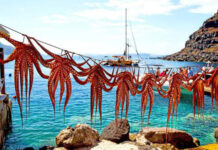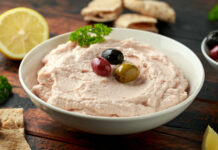To eat out in Greece is to experience a specific tradition at work. Rich and poor, young and old, all enjoy their favorite local restaurant, taverna or cafe. Greeks consider that the best places to eat are those where the food is fresh, served in big portions and well cooked. Visitors too have come to appreciate the simplicity and health of the traditional Greek kitchen- olive oil, yoghurt, vegetables, a little meat or fish and some wine, always shared with friends.
TYPES OF RESTAURANT
The estiatorion, a traditional Greek restaurant, is often difficult to find in bigger tourist resorts, but is one of Europe’s most enjoyable places to eat. Friendly, noisy and sometimes in lovely surroundings, estiatoria represent a reliable hub of local recipes and wines, particularly if they have been owned by the same family for decades. Foreigners unfamiliar with Greek dishes may be invited into the kitchen to choose their fare. In Greece, it is very common that the entire family dines together and takes lots of time over the meal, especially on the weekends.
Many traditional restaurants specialize in either a regional cuisine, a method of cooking, or a certain type of food. In some Northeast Aegean islands such as Lesvos, where a small minority of Greeks from Asia Minor have settled, food may be spicier than the Greek norm, with lots of red peppers and such dishes as giogurtlu (kebabs drenched in yoghurt and served on pita bread).
The menu in a traditional restaurant tends to be short, comprising at most a dozen mezedes (appetizers or snacks), eight main dishes, four or five vegetable dishes and salads, plus a dessert or fresh or cooked fruit and a selection of local and national wines.
Restaurants in Greece vary from very expensive in the main island towns to the very inexpensive. The cheapest of the traditional restaurants is known as mageirio, though they are becoming increasingly rare. Here there is a little choice in either wines or dishes, all of which will be mageirefta (ready- cooked), but the food is home made and tasty and the barrel wine which can be very good often comes from a local village.
Many hotels have restaurants open to non- residents. Large hotels in the islands and mainland offer more expensive, international cuisine. Some will also offer a typical Greek menu, which often times tends to be a nicer presentation of traditional dishes. Smaller hotels, however, occasionally have great menus and serve good local wines.
TAVERNAS
One of the great pleasures for a traveller in Greece is the tradition of taverna, a place to eat and drink, even if you simply snack on some mezedes.
Traditional taverns open mid- evening and stay open late, occasionally they are also open for lunch. Menus are short and seasonal- perhaps six or eight mezedes and four main courses along with the usual accompaniments of vegetables, salads, fruit and wine.
Some taverns specialize in the foods and wines of the owner;s home region, some in a particular cooking style and others in certain foods.

A psarotaverna is the place to find good fish dishes. In small fishing villages you may find the rickety tables on the beach. Close to the waves the owner may serve fish, such as red mullet, bass and octopus, very often that he himself caught that morning. The large fish restaurants in the tourist area may serve frozen or imported fish although the law stipulates that menus must state whether fish is fresh or frozen.
For delicious grills, try a psitaria, a tavern that specializes in spit- roasts and char- grilling. In the countryside, you may find lamb, kid, pork, chicken, game, offal and even testicals char- grilled.
At the harborside, fish and shellfish are grilled (broiled) and served with fresh lemon juice and olive oil.
CAFES AND BARS
Cafes , known as kafeneia are the pulse of Greek life and even the tiniest hamlet has a place to drink coffee and wine. Equally important is its function as the center of communication- mail is collected here and newspapers read and discussed.
All kafeneia serve Greek coffee sometimes frappe (instant coffee served cold in a tall glass), soft drinks, beer ouzo and local wine. Most also serve some kind of snack that you can order. All are usually open from early in the morning and remain open until late at night.
A galaktopoleio, or “milk shop” has a seating area where you can enjoy fine yoghurt and honey.
A kapileio (wine shop with caffe bar attached) is the place to try local wines from the cask. If you are lucky, you may find a few bottled wines too. The owner is usually from a wine village or family, and will often cook some simple regional specialty to accompany the wine.
In a mezedopoleio, or mezes shop, the owner will not only serve the local wine and the mezedes that go with it, but also ouzo and the infamous spirit raki, both made of the remnants of the grape harvest. Their accompanying mezedes are less salty than those served with wine.

No holiday in Greece is complete without a visit to ouzeri. You can order a dozen or more little plates of savoury meats, fish and vegetables and try the many varieties of ouzo, served in small jugs with a glass of water, to wash the ouzo down. It is a very noisy but a fun place to eat and drink.
FAST FOOD AND SNACKS
Visitors can be forgiven for thinking Greeks never stop eating, for there seem to be snack bars on every street corner and vendors selling sweets, nuts, rolls, seasonal corn and chestnuts at every turn.
Although American style fast- food places dominate most of the tourist centers, it is very easy to avoid them by trying the traditional Greek cuisine. Try the food of the extremely cheap souvlatzidiko which offers a mostly take away service of souvlaki– chunks of meat, fish or vegetables, grilled or roasted on the skewer- with fresh bread.

The ovelistirio serves gyros– meat from a revolving spit in a pita bread pocket. This type of food is sold to take away.
Many bakeries sell savoury pies filled with spinach and/or cheese and you will also easily find bars and cafes where you can have a local snack or salad.
If you have a sweet tooth you will love zacharoplasteio (“sugar sculptor” shop). The baker prepares traditional sweet breads, small sweet candies and pastries and different varieties of fragrant honey cakes.

Traditional restaurants and taverns may only stock carafe wines which is served straight from the barrel and is always inexpensive. Carafe wines are often of the region and the Greek rose in particular is noted for having an unusual but pleasant flavor.
Vegans may have a little more difficulty but, as Greek cuisine relies very little on dairy products, it is possible to follow a vegan diet on any of the Greek islands.





